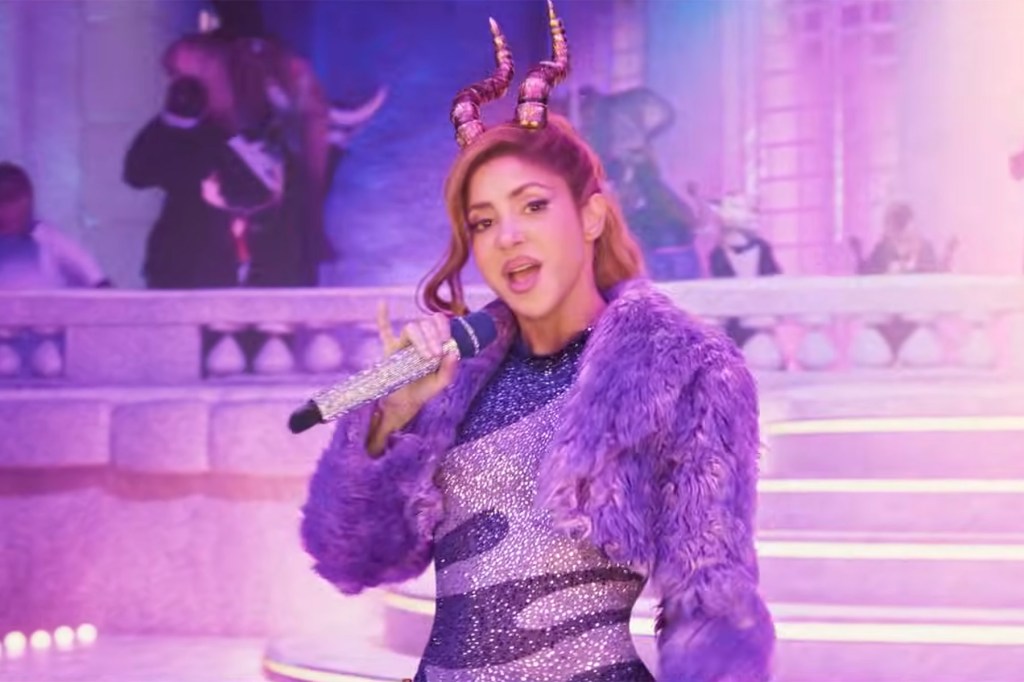Latin
Page: 5

Trending on Billboard Rauw Alejandro proved why he remains one of Latin music’s most dynamic performers on Thursday (Nov. 13) night at the 26th annual Latin Grammy Awards. Taking the stage with his smooth vocals and jaw-dropping choreography, the Puerto RIcan superstar delivered a medley that showcased his ability to effortlessly transition between genres, from tropical […]
Trending on Billboard Latin music stars dripped elegance on the red carpet of the Latin Grammy Awards 2025 on Thursday (Nov. 13), which took place at the MGM Grand Garden Arena in Las Vegas. Chilean singer-songwriter Mon Laferte was among the early arrivals, dressed from head to toe in a glamorous femme-fatale look, a nod […]

Trending on Billboard
Mexican music star Netón Vega wraps up a successful 2025 with the release of an ambitious project: his second studio album, Delirium. In it, he experiments with a variety of sounds and teams up with renowned songwriters and producers such as Edgar Barrera and Benny Blanco.
Explore
See latest videos, charts and news
Coming out on Thursday night (Nov. 13) under La Josa Records — just three weeks after Vega won the Billboard Latin Music Award for artist of the year, debut — Delirium features 15 tracks, including the previously released single “Qué Motor,” the focus track “Lentes” and several standout collaborations: “AQNGP” with Ryan Castro, “90 60 90” with Myke Towers, “Baby de los 2 Miles” with Jowell & Randy, and “Perro Fiel” with Benny Blanco.
In addition to Mexican music — the genre that first launched his career as a songwriter for stars like Peso Pluma and Tito Double P, and later as a singer with last year’s hit “Loco” — the album brings reggaetón, rap, and bachata, brimming with lyrics about love and heartbreak designed to resonate with anyone.
Delirium follows Mi Vida Mi Muerte, which debuted at No. 1 on Billboard‘s Regional Mexican Albums chart and No. 2 on the Top Latin Albums chart dated March 8.
In an exclusive interview in Las Vegas, the city he chose to debut his new music, Netón Vega talks about his year of successes, his new album, how his collaboration with Benny Blanco came about, and more.
What’s your take on how this year has been for your career?
It’s been a year full of changes, surprises, and very fast growth since the release of my first album. Thank God, people really liked it.
You just won the Billboard Latin Music Award for artist of the year, debut. What was that experience like for you?
Honestly, I wasn’t expecting it — it was a big surprise. I had eight nominations, so I was hopeful to win something, and it happened. I was really excited and nervous, especially because I didn’t have anything prepared to say. I’m truly grateful to the people.
Was having Edgar Barrera as one of the producers of your new album Delirium meant to create global and commercial music?
I had already worked with him. In fact, we have a great friendship, so when I told him about what I wanted to do with my new album, he supported me all the way. Edgar brought his intelligence and experience; he knows what people like. I always respect people with a strong track record and learn from their knowledge. I’m still learning, so I truly value other people’s work.
It’s surprising that Benny Blanco is another one of the producers and even collaborated on a track. How did that connection come about?
I never would have imagined meeting him, let alone recording with him. It happened thanks to someone on my team who made the connection. We had two sessions, nothing planned — everything just came together in the moment. The first song we created was “Perro Infiel,” which is the collaboration, and the next day we worked on another track for him, and he produced several more for the album.
How did you manage to work together without knowing each other?
He only speaks English and I only speak Spanish, but someone on my team translated for us. There was good energy from the start. He gives you your space — we have different ways of working, but in the end, we both stepped out of our comfort zones and created things we really liked. He’s used to working with very big artists, but he took the opportunity to work with me.
You’re already a big artist. Are you aware of that?
Yes, I know. And there are many things I don’t know, but I’m learning. Everyone, in any profession, starts from scratch and builds experiences over time — same with me.
Your album Delirium has a bit of everything. Anyone, from any age group, can enjoy one or more songs.
I mainly focused on making the album enjoyable, with positive energy, and something more people could listen to. I don’t want to stick to just one thing — you have to try and experiment. This album is a reflection of everything I’m experiencing. I wanted to break away from the usual and explore new sounds.
What’s left to do for the rest of this important year in your career?
On November 28, I’ll be at the Peacock Theater in Los Angeles — it’s my last show of the year. After that, I’ll take some much-needed vacation time and go to Mexico to be with my family, because they are the driving force that keeps me going.
Trending on Billboard The Latin Recording Academy hosted its 2025 Best New Artist Showcase on Tuesday night (Nov. 11), giving the spotlight to 10 promising acts in Latin music. Held at the Mandalay Convention Center, the intimate concert kicked off at 9:30 p.m. with a heartfelt performance by Aitana, who also hosted the event. Presenters […]
Trending on Billboard
Glitz and glam took over the Mandalay Convention Center in Las Vegas on Wednesday (Nov. 12), where industry leaders and Latin music stars alike gathered for a night of celebration at The Latin Recording Academy’s 2025 Person of the Year gala honoring Raphael.
Explore
See latest videos, charts and news
“We are celebrating a living legend of Latin music,” Manuel Abud, CEO of The Latin Recording Academy, said to attendees before inviting the 82-year-old Spanish singer-songwriter to the stage. “Let’s welcome an iconic artist who is undoubtedly a legend in Spanish-language music. He created a personal style that has transcended generations and borders. Today, we will be telling your story through your music. We’ve invited friends and colleagues, but also artists from the new generation who recognize your career.”
The invite-only gala that finished around midnight included a three-course dinner, a two-hour long tribute to Raphael, and a five-minute video that showcased Raphael’s more than 65 years in music: “I see colleagues of mine retiring. I’m not going to retire,” he said in one of the clips. “I still have many countries to visit, and as long as my voice holds up, I’ll be singing.”
At 9:30 p.m., Enrique Bunbury opened the show with a soft rock version of Raphael’s 1966 classic “Yo Soy Aquel.” He was then joined by Carin León for some jaw-dropping harmonies during a performance of “Ahora.” León then stayed to perform 1988’s “Toco Madera.” Later in the evening, Fito Paez and Rozalen performed “Enséñame a Olvidarte”; Rozalen brought out Susana Baca for a “Chabacano, Limeña” duet; and Pepe Aguilar was joined by Myriam Hernandez for a sweet rendition of “Procuro Olvidarte.”
Cafe Quijano, Gaby Moreno, Elena Rose, Ivan Cornejo, Jesse & Joy, Pablo Lopez, Aitana, Kiki Morente, Angeles Toledano, Vanessa Martín, Kany Garcia, and Carlos Rivera, were among the many artists who also honored El Divo de Linares with their captivating vocals. “I would clone you,” García told him. “You are a magical human being. Long live Raphael, this is your night!”
The highlight of the night, however, was when David Bisbal performed the timeless 1980s ballad “Como Yo Te Amo.” At one point in the powerful performance, Bisbal walked off stage and sat across Raphael at the dinner table, where he was joined by his loved ones. Bisbal passionately sang to him as a teary-eyed Raphael smiled and sang along.
“The truth is, Raphael, we’re friends, and thank you for leaving a legacy of discipline, effort, and sacrifice… I don’t know how many times you sang while sick,” Bisbal said to him. “That’s the legacy you’ve left for all artists. You can count on me to always carry your word. I promise you.”
The evening wrapped up with the rhythmic 1992 tune “Escándalo” performed by tropical stars Willy Chirino (who composed the song for Raphael’s Ave Fénix album), Eddy Herrera, and Victor Manuelle.
Raphael — who was diagnosed last year with primary brain lymphoma — then briefly took the stage to remind his family, friends, and colleagues in the room: “I hope to return for many more years.”
Trending on Billboard Shakira is set to return as pop star Gazelle for Disney’s Zootopia 2, and the colorful music video for “Zoo,” her original song in the film, premiered on Wednesday (Nov. 12). In the three-minute clip, the Colombian hitmaker channels her character appearing in multiple Gazelle-inspired looks, and she shares a number of […]

Trending on Billboard
Italian icon Laura Pausini was honored with Billboard Italy’s prestigious Global Icon award on Wednesday (Nov. 12) during a historic Vatican ceremony with Pope Leo XIV. As part of Billboard Italia Women in Music 2025, the ceremony also emphasized the vital role of amplifying women’s voices in the music industry, with the Pope receiving a commemorative plaque underscoring this mission. Pausini’s remarkable career and humanitarian efforts continue to elevate Italian music on a global scale.
Explore
See latest videos, charts and news
The superstar also presented Pope Leo XIV with a unique, unreleased song — her rendition of “Brother Sun, Sister Moon,” inspired by Saint Francis of Assisi’s “Canticle of the Creatures.” The song celebrates universal brotherhood and the praise of God through creation.
Pausini has elevated Italian music to a global stage, serving as an ambassador for universal values such as inclusion, solidarity, and peace. She has consistently worked to support the most vulnerable, including children and populations affected by humanitarian crises. Her collaborations with organizations including UNICEF, Save the Children, Amnesty International and the World Food Programme — where she served as an ambassador — further highlight her commitment to humanitarian causes. Recognized as the most awarded Italian artist in the world, Pausini was honored with the “Icon” award at the 2025 Billboard Latin Music Awards in October, presented by Ozuna.
The second Italian edition of Billboard Women in Music will take place in Milan on Nov. 25, 26, and 28, coinciding with the International Day for the Elimination of Violence Against Women. Across the three days, eight additional awards will be presented to individuals shaping the Italian music scene, including leading artists and professionals working behind the scenes.
Laura Pausini has sold over 75 million records worldwide and garnered more than 6 billion streams, solidifying her status as the most listened-to Italian female artist internationally. She is also the first and only Italian female artist to win a Grammy Award and has entered the all-genre Billboard Hot 100.
Throughout her career, she has won four Latin Grammy Awards and was named Person of the Year 2023 by the Latin Recording Academy, becoming the first non-native Spanish-speaking artist to receive this honor. Her accolades also include a Golden Globe, an Emmy Award nomination, and an Oscar nomination.
She has collaborated with renowned artists such as Luciano Pavarotti, Andrea Bocelli, Michael Bublé, Ray Charles, Phil Collins, Shakira, Mariah Carey and Michael Jackson, among many others. Her recent collaborations include a live performance with Alanis Morissette and a duet with Robbie Williams for the first official FIFA anthem.
Her upcoming album, Io Canto 2, will be released by Warner Music in 2026, with a Spanish version titled Yo Canto 2. The album marks her return to both recording and live performances, accompanied by a new world tour in 2026 and 2027, kicking off on March 27 in Pamplona, Spain.
Trending on Billboard After taking place in Miami last year, the Latin Grammy Awards returns to Las Vegas for 2025, taking place Thursday (Nov. 13) at the MGM Grand Garden Arena. Puerto Rican hitmaker Bad Bunny leads the list of nominees this year with 12 nods, including for album of the year (Debí Tirar Más Fotos) and […]
Here’s how the Internet is reacting to Rosalía’s new music.
11/10/2025
Trending on Billboard
Since the late 1990s, Mexico City’s Plaza de la Constitución, better known as the Zócalo, has been the spot for musical events that have turned the country’s main public square into the biggest stage for massive and unforgettable shows.
The last major crowd event hosted at the so-called First Square of the nation’s capital was the screening of the iconic Mexican singer-songwriter Juan Gabriel’s first concert at the Palacio de Bellas Artes in 1990. This event, held last Saturday (Nov. 8), brought together 170,000 people, according to data from the city government. The screening was organized by Netflix to promote the docuseries Juan Gabriel: I Must, I Can, I Will (or in Spanish, Juan Gabriel: Debo, puedo y quiero), which had premiered just days earlier.
This was the second time a concert by the late “Divo de Juárez” at Bellas Artes was screened in the plaza. A similar event took place in September 2024, when the screening of his 2013 performance at Mexico’s most prestigious cultural venue drew 70,000 people.
Mexico City’s Zócalo is considered an iconic and highly significant location, as it is a square full of symbolism where politics, social movements, culture, and religion converge. It is the second-largest public square in the world, only behind Tiananmen Square in Beijing.
One of the earliest recorded concerts held at the Zócalo was by Los Tigres del Norte in 1999, which lasted nearly three hours. Since then, Paul McCartney, Roger Waters, Justin Bieber, Shakira, Los Fabulosos Cadillacs and Grupo Firme have been among the artists who have performed there in front of thousands of people — in some cases even declaring that this was the “biggest” show of their careers, as happened with Spanish star Rosalía and New York band Interpol.
Here are the 12 most massive concerts held in recent years at Mexico City’s Zócalo, according to official figures from the city government. Check out which one takes the No. 1 spot!
Editor’s Note: The list is ranked from lowest to highest attendance and only includes live performances. In the case of a tie, entries are listed in alphabetical order.
Los Tigres del Norte

 State Champ Radio
State Champ Radio 




